Anemarrhena asphodeloides – Zhi Mu,Anemarrhena
[Medicinal Use] This product is the rhizome of Anemarrhena of the Liliaceae family.
[Nature and flavor and meridians] Bitter, cold. Enters the lung, stomach, and kidney meridians.
[Effects] Clears heat and purges fire, nourishes the kidney and moistens dryness.
[Clinical Application] 1. Used for fever, high fever, irritability, thirst, and strong pulse, as well as lung heat, cough, and yellow and thick sputum.
Anemarrhena is bitter and cold, and can clear lung heat and stomach fire, so it is suitable for lung and stomach heat. This product is often used with gypsum to enhance the heat-clearing and fire-purging effects of gypsum.
2. Used for fever due to yin deficiency, cough due to consumptive disease, and thirst
Anemarrhena can purge lung fire and nourish the kidney, so it can not only clear excess heat, but also clear deficiency heat. In clinical practice, it is often used with Phellodendron chinense and added to yin-nourishing medicines, such as Zhibai Dihuang Wan, to treat yin deficiency, heat, and bone steaming. This product can be used with yin-nourishing and lung-moistening drugs such as Adenophora, Ophiopogon japonicus, and Fritillaria cirrhosa to treat lung deficiency and dry cough; it can be used with heat-clearing and fluid-promoting drugs such as Radix Trichosanthis, Ophiopogon japonicus, and Radix Puerariae to treat thirst.
[Prescription name] Fat Anemarrhena, Anemarrhena (raw, with stronger fire-clearing effect), Stir-fried Anemarrhena (stir-fried, with slightly milder fire-clearing effect), Stir-fried Anemarrhena with salt water (better for nourishing yin and relieving deficiency heat)
[Dosis dan penggunaan umum] Satu hingga tiga qian, direbus dan diminum.
[Comments] 1. Anemarrhena is bitter and cold but not dry. It can clear the lungs, cool the stomach, and relieve kidney fire. When combined with Scutellaria baicalensis, it can relieve lung fire; when combined with Gypsum, it can clear stomach heat; when combined with Phellodendron chinense, it can relieve kidney fire.
2. Anemarrhena can both clear real heat and relieve deficiency heat, but its effect of nourishing yin and fluid is relatively weak. It must be combined with yin-nourishing drugs to play its role when used for symptoms such as yin deficiency and internal heat, lung deficiency and dry cough, and thirst.
3. This product can moisten the intestines, so it is not suitable for people with spleen deficiency and loose stools.
[Example of prescription] Zhibai Dihuang Wan “Yi Zong Jin Jian”: Anemarrhena, Phellodendron, Rehmannia, Cortex Moutan, Cornus, Chinese Yam, Alisma, Poria. Treats Yin deficiency and excessive fire, bone steaming and hot flashes, and frequent dreams and spermatorrhea.
This product is the dried rhizome of Anemarrhena asphodeloides Bge, a plant of the Liliaceae family. It is dug in spring and autumn, the fibrous roots and mud are removed, and it is dried in the sun. It is commonly called “hairy Anemarrhena”; or the outer skin is removed and dried in the sun.
[Properties] This product is long and slightly curved, slightly flat, and occasionally branched. It is 3~15cm long and 0.8~1.5cm in diameter, with light yellow stem and leaf residues at one end. The surface is yellow-brown to brown, with a groove on the top and closely arranged ring nodes. The nodes are densely covered with yellow-brown residual leaf bases, growing from both sides to the top of the rhizome; the bottom is raised and slightly wrinkled, and there are sunken or protruding dot-shaped root marks. It is hard, easy to break, and the cross section is yellow-white. It has a slight odor, tastes slightly sweet and slightly bitter, and is sticky when chewed.
[Identifikasi]
(1) The powder of this product is yellow-white. The mucous cells are round, oval or fusiform, with a diameter of 53~247μm, and the cell cavity contains bundles of calcium oxalate needles. The calcium oxalate needles are bundled or scattered, with a length of 26~110μm.
(2) Take 0.5g of the powder of this product, add 10ml of dilute ethanol, and ultrasonically treat for 20 minutes. Take the supernatant as the test solution. Take another mangoside reference substance, add dilute ethanol to make a solution containing 0.5mg per 1ml, as the reference substance solution. According to the thin layer chromatography method (General Rule 0502), 4u of each of the above two solutions were taken and spotted on the same polyamide film. Ethanol-water (1:1) was used as the developing agent. The film was developed, taken out and dried, and then examined under ultraviolet light (365nm). In the chromatogram of the test sample, fluorescent spots of the same color appeared at the corresponding positions of the chromatogram of the reference sample.
(3) Take 0.2g of the powder of this product, add 10ml of 30% acetone, and ultrasonically treat for 20 minutes. The supernatant was taken as the test solution. Take another reference substance of Anemarrhena saponin B, add 30% acetone to make a solution containing 1mg per 1ml, which was used as the reference solution. According to the thin layer chromatography method (General Rule 0502), take 4 of each of the above two solutions and spot them on the same silica gel G thin layer plate. Use the upper layer solution of n-butanol-glacial acetic acid-water (4:1:5) as the developing agent, develop, take out, dry, spray with vanillin sulfuric acid test solution, and heat at 105℃ until the spots are clearly colored. In the chromatogram of the test sample, spots of the same color appear at the corresponding positions of the chromatogram of the reference sample.
[Inspeksi]
Water content shall not exceed 12.0% (General Rule 0832 Method 2)
Total ash content shall not exceed 9.0% (General Rule 2302)
Acid insoluble ash content shall not exceed 4.0% (General Rule 2302). 【Content determination】
Mangoside was determined according to the high performance liquid chromatography method (General Rule 0512)
Chromatographic conditions and system suitability test: octadecylsilane bonded silica gel was used as filler: acetonitrile-0.2% glacial acetic acid aqueous solution (15:85) was used as mobile phase; the detection wavelength was 258nm. The theoretical plate number of the mangoside peak should not be less than 6000.
Preparation of reference solution: Take an appropriate amount of mangoside reference, accurately weigh it, add dilute ethanol to make a solution containing 50ug per 1ml, and obtain it. Preparation of test solution: Take about 0.1g of the powder of this product (passed through No. 3 sieve), accurately weigh it, put it in a stoppered conical bottle, accurately add 25ml of dilute ethanol, weigh it, ultrasonically treat it (power 400W, frequency 40kHz) for 30 minutes, let it cool, weigh it again, make up the lost weight with dilute ethanol, shake it well, filter it, and take the filtrate to obtain it.
Determination method: Accurately aspirate 10u of reference solution and test solution respectively, inject into liquid chromatograph, and determine.
This product, calculated on the basis of dry product, contains not less than 0.70% mangiferin (C1gH18011).
Anemarrhena saponin BI is determined according to high performance liquid chromatography (General Rule 0512)
Chromatographic conditions and system suitability test: Octylsilane bonded silica gel is used as filler; acetonitrile-water (25:75) is used as mobile phase; evaporative light scattering detector is used for detection. The theoretical plate number calculated based on the Anemarrhena saponin BⅡ peak should not be less than 10,000.
Preparation of reference solution Take an appropriate amount of Anemarrhena saponin BⅡ reference substance, weigh it accurately, add 30% acetone to make a solution containing 0.50mg per 1ml, and the test solution is prepared. Take about 0.15g of the powder of this product (passed through No. 3 sieve), weigh it accurately, put it in a stoppered conical bottle, accurately add 30% acetone 25ml, weigh the weight, ultrasonically treat (power 400W frequency 40kHz) for 30 minutes, take it out, cool it, weigh it again, make up the lost weight with 30% acetone, shake it. Filter it, take the filtrate, and get it.
Determination method Accurately take 5u1, 10u of the reference solution and 5~10u of the test solution, inject them into the liquid chromatograph, determine, and calculate with the external standard two-point method logarithmic equation to get it. This product, calculated on the basis of dry product, contains not less than 3.0% of Anemarrhena saponin BⅡ (C45H76019)
Potongan rebusan
[Pengolahan]
Remove impurities, wash, moisten thoroughly, cut into thick slices, dry, and remove hair. Anemarrhena
[Properti]
This product is in irregular round thick slices. The outer skin is yellow-brown or brown, with a small amount of remaining yellow-brown leaf base fibers and sunken or protruding dot-shaped root marks. The cut surface is yellow-white to yellow. The smell is slight, the taste is slightly sweet and slightly bitter, and it is sticky when chewed.
[Inspeksi]
Acid-insoluble ash Same as medicinal materials, not more than 2.0%.
[Content determination] Same as medicinal materials, containing not less than 0.50% mangiferin (C1gH18011), and not less than 3.0% Anemarrhena saponin BⅡ (C45H7601g).
[Identification][Inspection]
(Moisture and total ash) Same as medicinal materials.
Take the slices of Anemarrhena asphodeloides and fry them dry according to the salt water roasting method (General Rule 0213)
[Properti]
This product is shaped like Anemarrhena asphodeloides slices, yellow or slightly burnt. Taste slightly salty
[Inspeksi]
Acid insoluble ash Same as the medicinal material, not more than 2.0%.
[Penentuan konten]
Same as the medicinal material, containing mangoside (C1gH18011) not less than 0.40%, containing Anemarrhena saponin BⅡ (C45H7601g) not less than 2.0%.
[Identification][Inspection]
(Moisture total ash) Same as the medicinal material.
[Alam dan rasa dan meridian]
Bitter, sweet, cold. Enter the lung, stomach, and kidney meridians.
[Fungsi dan Indikasi]
Clears heat and purges fire, nourishes yin and moisturizes dryness. Used for exogenous febrile diseases, high fever and thirst, lung heat and dry cough, bone steaming and hot flashes, internal heat and thirst, intestinal dryness and constipation.
[Cara Pemakaian dan Dosis]
6~129.
[Penyimpanan]
Place in a ventilated and dry place, moisture-proof. Where is the main production area of Anemarrhena?
It is mainly produced in Hebei, Shanxi, Shaanxi, and Inner Mongolia.
Where is the main medicinal part of Anemarrhena?
Medicinal part of Anemarrhena:
The dried rhizome of Anemarrhena asphodeloides Bge., a plant of the Liliaceae family.
Features of the medicinal part of Anemarrhena:
This product is long and slightly curved, slightly flat, and occasionally branched, 3~15cm long, 0.8~1.5cm in diameter, with light yellow stem and leaf scars at one end. The surface is yellow-brown to brown, with a groove on the top, with closely arranged ring nodes, and densely yellow-brown residual leaf bases on the nodes, growing from both sides to the top of the rhizome; the bottom is raised and slightly wrinkled, and there are sunken or protruding dot-shaped root scars. It is hard, easy to break, and the cross section is yellow-white. It has a slight smell, tastes slightly sweet and slightly bitter, and is sticky when chewed.
How is Anemarrhena recorded in ancient books?
《本经》: “It is used to treat thirst, heat, remove evil spirits, limb edema, relieve water, replenish deficiency, and invigorate qi.
《日华子本草》: “It clears the small intestine, eliminates phlegm and stops cough, moistens the heart and lungs, replenishes deficiency, calms the mind and stops palpitations.
《用药法像》: “It drains the kidney fire without roots, treats bone steaming with sweat, stops the heat of asthenia, and nourishes the yin of the source.
《本草刚目·卷十二上》: “The bitter, cold and cool taste of Anemarrhena moistens the kidney dryness and nourishes yin. It clears the lung metal and drains fire, and is a medicine for the two meridians.
Efek
Anemarrhena has the effects of clearing heat and draining fire, nourishing yin and moistening dryness.
What are the main effects and clinical applications of Anemarrhena?
Anemarrhena is used for exogenous febrile diseases, high fever and thirst, lung heat and dry cough, bone steaming and hot flashes, internal heat and thirst, and intestinal constipation.
Qi-level heat syndrome
It is often used together with gypsum.
Lung heat and dry cough
Often used with Fritillaria.
Internal heat and thirst, dry intestines and constipation
To treat thirst caused by yin deficiency and internal heat, it is often used together with Radix Trichosanthis, Radix Puerariae, etc.
To treat dry intestines and constipation, it is often used together with Radix Rehmanniae, Scrophulariae, Radix Ophiopogonis, etc.
Bone steaming and hot flashes
To treat bone steaming and hot flashes caused by yin deficiency and excessive fire, restlessness and night sweats, etc., it is often used together with Cortex Phellodendri, Radix Rehmanniae, etc.
What other effects does Anemarrhena have?
In my country’s traditional food culture, some Chinese medicinal materials are often widely consumed as food ingredients among the people, that is, substances that are both food and Chinese medicinal materials according to tradition (i.e. edible drug substances). According to the documents issued by the National Health Commission and the State Administration for Market Regulation, Anemarrhena can be used as both medicine and food within a limited range of use and dosage.
Commonly used medicinal diet recipes for Anemarrhena asphodeloides are as follows
·Tracheitis, cough, pulmonary tuberculosis: 500g of kelp, 500g of Stemona, 1kg of Anemarrhena asphodeloides (honey-fried), soaked in 50% ethanol for 1 week, recover the ethanol, and add distilled water to 5L. 10mL each time, 3 times a day.
Hot at night and cool in the morning, no sweat and bone steaming: 6g of Artemisia annua, 15g of turtle shell, 12g of fine Rehmannia root, 6g of Anemarrhena asphodeloides, 9g of Paeonia suffruticosa, simmer on low heat for 2-3 hours until the turtle shell is crispy, eat the turtle meat and drink the soup, 1 small bowl each time, 2 times a day.
Nourishing yin and clearing heat, moistening the lungs and relieving cough: 1 turtle, 6g of Fritillaria cirrhosa, 6g of Anemarrhena asphodeloides, 6g of almond, 6g of Peucedanum chinense, 6g of Bupleurum chinense. Onion, ginger, pepper, salt, sugar, rice wine, and MSG in appropriate amounts. Take in divided doses.
What are the compound preparations containing Anemarrhena asphodeloides?
Baihu Decoction
Clears heat and produces body fluid. Indications: Heat syndrome of qi division. High fever, red face, thirst, sweating, aversion to heat, strong and powerful pulse.
Ermu Ningsou Pills
Clear the lungs, moisten dryness, resolve phlegm and stop coughing. Used for cough caused by dryness and heat in the lungs, yellow and sticky phlegm that is difficult to cough out, chest tightness and shortness of breath, chronic cough, hoarseness and sore throat.
Ermu Ansou Pills
Clear the lungs, resolve phlegm, stop coughing and asthma. Used for chronic cough due to asthenia, cough, phlegm and asthma, bone steaming and hot flashes, hoarseness and heavy voice, dry mouth and tongue, and phlegm.
Pil Zhibai Dihuang
Nourishes yin and reduces fire. Used for yin deficiency and fire, hot flashes and night sweats, dry mouth and pain, tinnitus and spermatorrhea, and short and red urine.
Pil Dabuyin
Nourishes yin and reduces fire. Used for yin deficiency and fire, hot flashes and night sweats, coughing and hemoptysis, tinnitus and spermatorrhea.
Shengxian Decoction
Yin-tonifying and ascending qi. Indications: Qi sinking syndrome. Shortness of breath, not enough to breathe, or trying to breathe, there is a sense of wheezing, or the breath is about to stop, in danger, pulse is slow and weak, or three-five irregular. Modern research progress on Anemarrhena
This product has multiple pharmacological effects such as anti-pathogenic microorganisms, antipyretic, anti-inflammatory, hypoglycemic, anti-stress gastric ulcer, anti-tumor, and improvement of learning and memory.
Pertanyaan yang paling sering ditanyakan oleh pasien
What are the effects and functions of Zhibai Dihuang Wan?
Zhibai Dihuang Wan is composed of Anemarrhena, Phellodendron, Rehmannia glutinosa, Cornus officinalis (processed), Peony Root, Chinese Yam, Poria, and Alisma.
It has the effect of nourishing yin and reducing fire. It is used for yin deficiency and fire, hot flashes and night sweats, mouth pain, tinnitus and spermatorrhea, and short and red urine.
The effects and functions of salt Anemarrhena?
Salt Anemarrhena is a processed product of Anemarrhena.
Anemarrhena is bitter, sweet, and cold in nature. It enters the lung, stomach, and kidney meridians. It has the functions of clearing heat and purging fire, promoting body fluid and moistening dryness. It is used for exogenous febrile diseases, high fever and thirst, lung heat and dry cough, bone steaming and fatigue, internal heat and thirst, intestinal dryness and constipation. Salted Anemarrhena can lead the medicine downward, specifically into the kidney, enhance the effect of nourishing yin and reducing fire, and clear away heat. It is used for liver and kidney yin deficiency, virtual fire inflammation, bone steaming and hot flashes, night sweats and spermatorrhea, waist and knee pain, and yin deficiency and urinary retention.
Penggunaan
Generally, Anemarrhena slices are used for decoction. Anemarrhena has the effects of clearing heat and purging fire, nourishing yin and moistening dryness.
How to use Anemarrhena correctly?
When Anemarrhena decoction is taken orally, the usual dosage is 6~12g.
After different processing methods, Chinese medicinal materials such as Anemarrhena and Salted Anemarrhena can be produced. It is suitable to use raw to clear and purge real fire, and it is suitable to stir-fry with salt water to nourish yin and reduce fire. Different processing methods have different effects, but the method of use is the same. Please follow the doctor’s advice for specific medication.
Anemarrhena is generally used in decoctions, decoctions are taken, and can also be made into powders or pills for consumption. However, the use of Chinese medicinal materials must be differentiated and treated according to syndrome differentiation. It should be used under the guidance of professional Chinese medicine practitioners. It should not be used at will, and it is even more forbidden to listen to Chinese medicine prescriptions and advertisements at will. Common Chinese medicine combinations are as follows:
· Zhimu with Huangbai: Zhimu can clear heat and purge fire, nourish yin and moisten dryness; Huangbai can clear heat and purge fire. The combination of the two medicines can clear heat, reduce fire and strengthen yin, and has a good effect on treating yin deficiency and hyperactivity of fire.
. Zhimu with Chuanbei: Zhimu can clear heat and purge fire, nourish yin and moisten dryness; Chuanbei can clear heat and resolve phlegm, moisten the lungs and relieve cough. The combination of the two medicines can nourish yin and moisten the lungs, clear heat and resolve phlegm, and treat yin deficiency and fatigue cough, dryness and heat cough.
In addition, Zhimu can also be used for daily health care, and the common methods of consumption are as follows:
Soaking wine: Zhimu can be combined with ginseng, deer antler, astragalus and other Chinese medicines to make wine, which has the effect of refreshing the brain and calming the mind; it can also be combined with Rehmannia glutinosa, wolfberry and other Chinese medicines.
The combination of medicines has the effect of invigorating qi and nourishing yin, and helping yang and replenishing purgation.
Boil water: Use 7 lilies and 9 grams of Zhimu to boil water and drink, which has the effect of clearing heat and nourishing yin.
How to prepare Anemarrhena?
Anemarrhena
Take the original medicinal material, wash, moisten, cut into thick slices, and dry. Remove the hair. Salt Anemarrhena
Take the clean Anemarrhena slices, put them in a frying container, heat them over a low fire, fry until they change color, spray salt water, fry until dry, take them out, cool them, and sieve out the debris. For every 100kg of Anemarrhena slices, use 2kg of salt.
Which drugs should be used with Anemarrhena at the same time with special attention?
The combined use of Chinese medicine and the combined use of Chinese and Western medicines require syndrome differentiation and clinical individualized treatment.
Jika Anda menggunakan obat lain, harap berkonsultasi dengan dokter sebelum meminum obat tersebut, dan informasikan kepada dokter mengenai semua penyakit yang Anda diagnosis dan rencana perawatan yang sedang Anda terima.
Petunjuk Pengobatan
Anemarrhena is cold and slippery in nature, so people with spleen and stomach deficiency and loose stools should not take it.
What precautions should be taken when using Anemarrhena?
People with spleen and stomach deficiency and loose stools should not take it.
During the medication period, you should pay attention to avoid eating cold, raw and cold foods, and spicy and greasy foods. Pregnant and lactating women: If you are pregnant, planning to become pregnant or are lactating, please inform your doctor in time and consult whether Chinese medicine can be used for treatment.
, Children: Children should take medicine under the guidance of a doctor and under the supervision of an adult.
Please keep the medicinal materials properly and do not give them to others.
How to identify and use Anemarrhena?
Gypsum and Anemarrhena
·Gypsum and Anemarrhena Both the mother and the child have the effects of clearing heat and purging fire, eliminating restlessness and quenching thirst, and are used to treat qi-related heat syndrome, with symptoms such as fever, thirst, sweating, and a strong pulse. The two are often used together.
The difference is that gypsum focuses on clearing the heat of the internal organs and purging the lung and stomach fire, and is used for lung heat cough and stomach fire toothache. In addition, calcined gypsum is used for astringent and muscle-generating, and is used for sores that do not heal after ulceration, eczema, burns, etc.: Anemarrhena is sweet and bitter, cold and moist, and has the effect of nourishing yin and moistening dryness. It is used for both lung heat cough and yin deficiency dry cough, internal heat and thirst, bone steaming and hot flashes, dry intestines and constipation, etc.
Anemarrhena and salt Anemarrhena
Anemarrhena is bitter, sweet, and cold in nature. It enters the lung, stomach, and kidney meridians. It has the functions of clearing heat and purging fire, promoting fluid and moistening dryness. It is used for exogenous febrile diseases, high fever and thirst, lung heat and dry cough, bone steaming and fatigue fever, internal heat and thirst, dry intestines and constipation, etc.
Anemarrhena raw products are bitter, cold, and slippery, and are good at clearing heat and purging fire, promoting fluid and moistening dryness. It is used for lung fire cough, lung heat cough, stomach heat congestion, high fever and thirst, dry stool and other symptoms. Salt Anemarrhena can lead the medicine downward, specifically into the kidney, enhance the effect of nourishing yin and reducing fire, and clear away heat. It is used for liver and kidney yin deficiency, virtual fire inflammation, bone steaming and hot flashes, night sweats and spermatorrhea, waist and knee pain, and yin deficiency and urine retention.



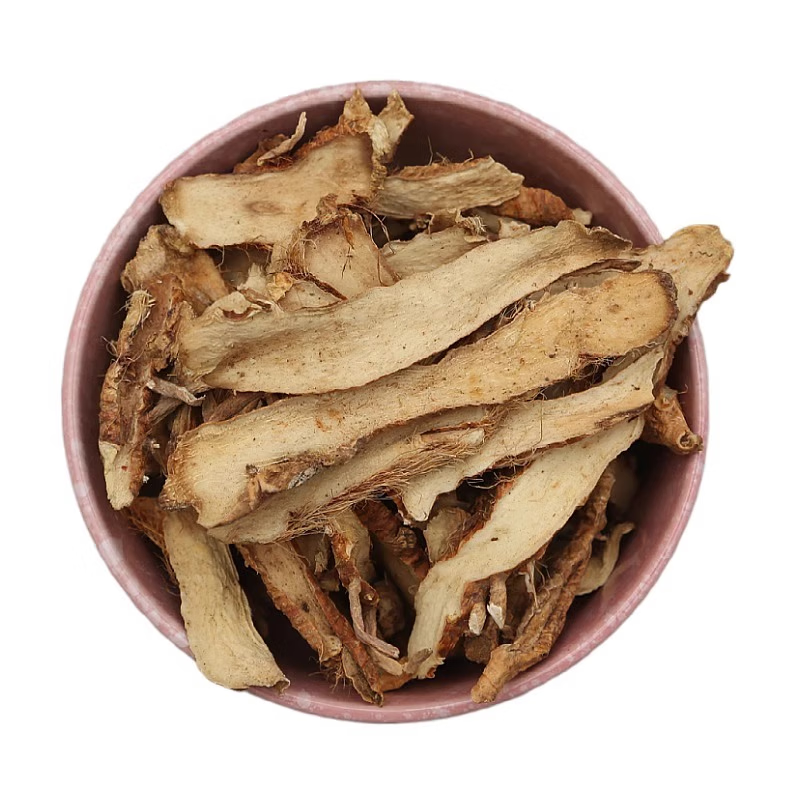




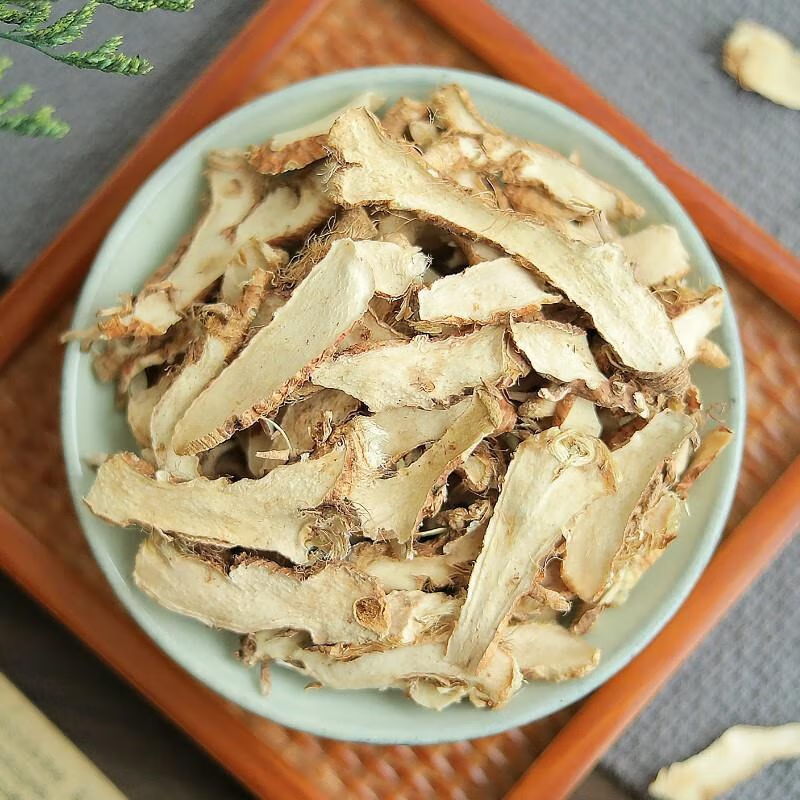



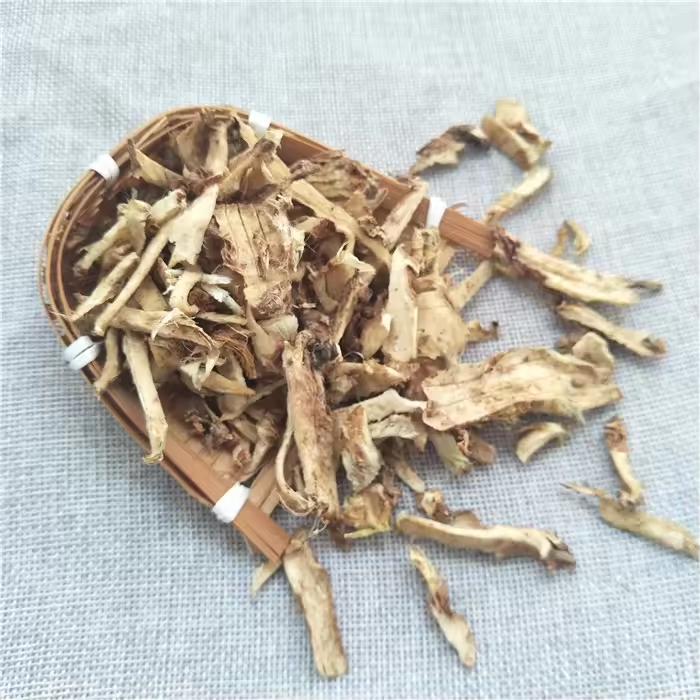

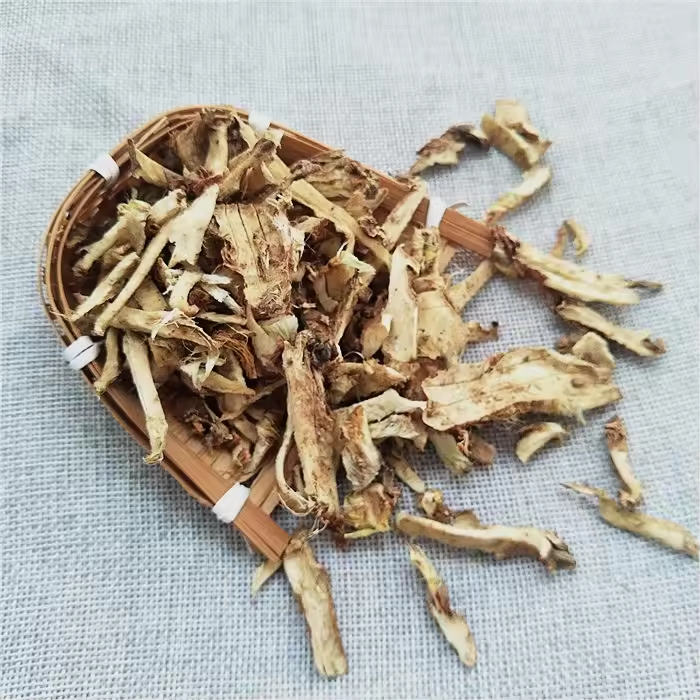


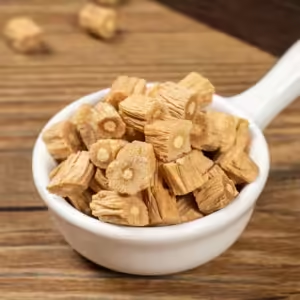

Ulasan
Belum ada ulasan.